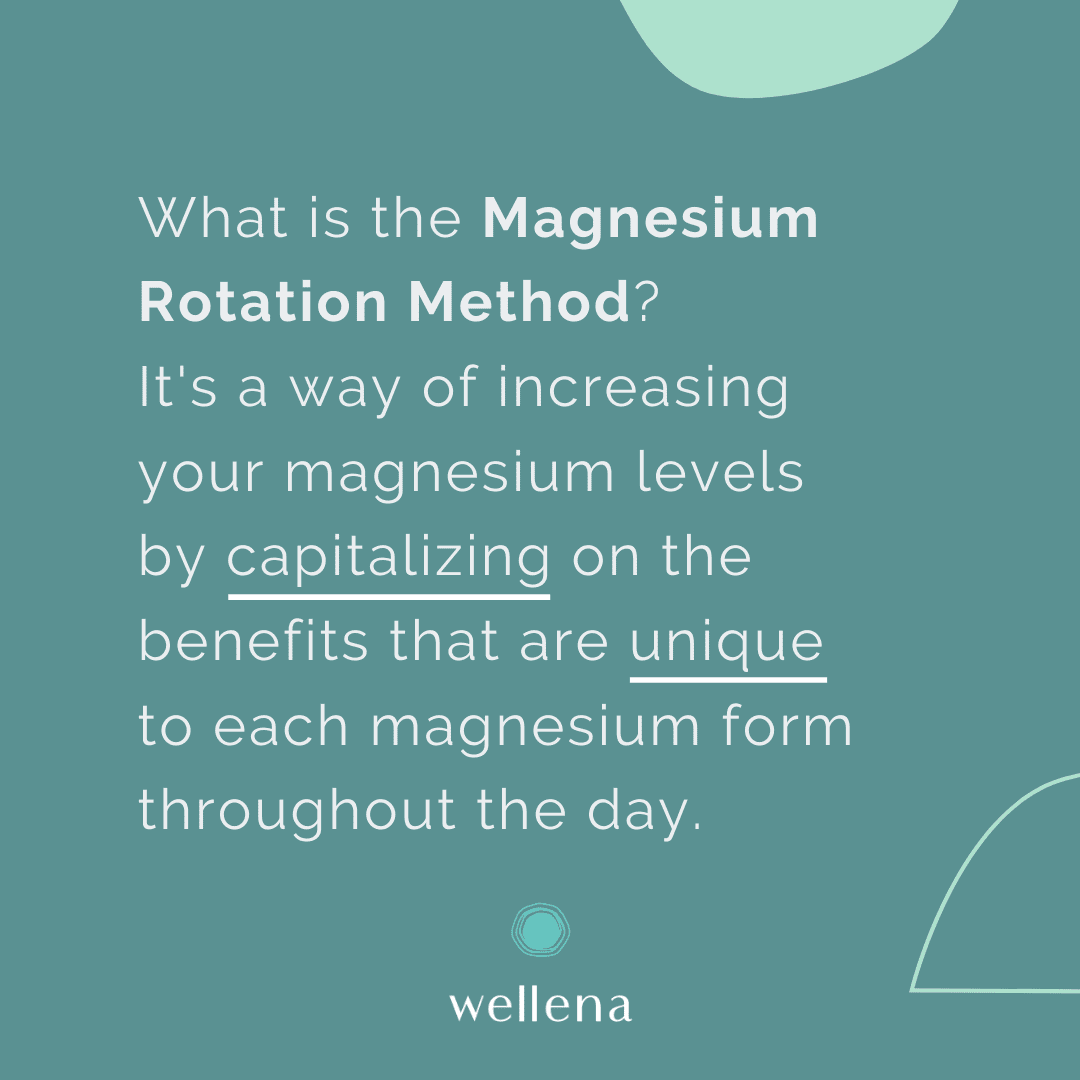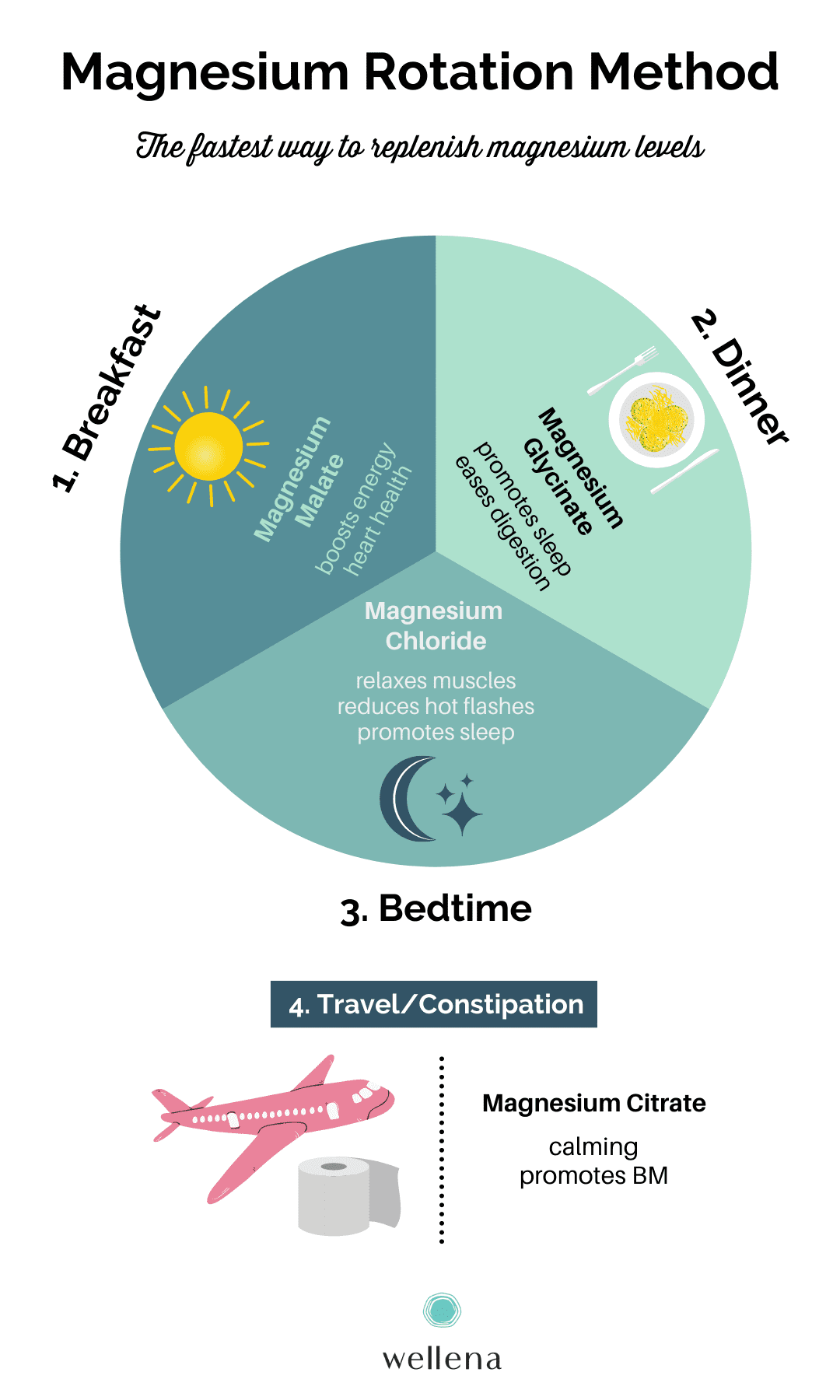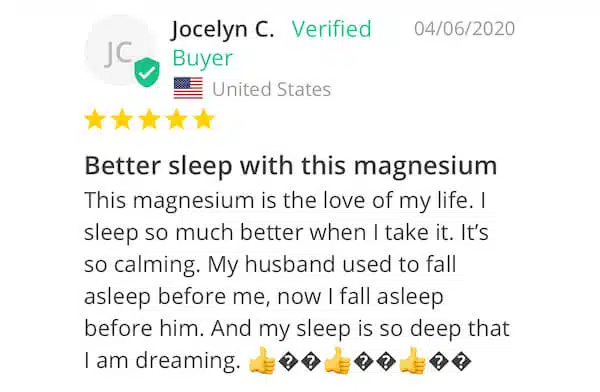
What You Will Learn in This Article
- Types of Magnesium
- Food Sources of Magnesium
- What is The Magnesium Rotation Method?
- How Much Magnesium Do You Need?
- How to Follow The Magnesium Rotation Method
If you want to achieve balanced hormones and optimal health, it’s important to achieve adequate levels of magnesium. Think you’re easily getting your RDA? Most of us aren’t. In fact, researchers have estimated that up to 75% of those who live in the United States may be deficient in magnesium.
Magnesium is needed for over 300 enzyme reactions in the body. The downstream effects of these enzyme reactions can affect inflammation levels, hormone production, blood sugar balance, digestion, sleep quality, and so much more. For that reason, a deficiency in this important mineral can seriously lower your quality of life.
The good news is that there are supplements that can complement your intake from your favorite healthy foods.
When you look at the various types of magnesium supplements out there, you may get overwhelmed with the variety that’s now available.
Do all types of magnesium all work the same way? No. With magnesium supplements, form determines function.
Some magnesium supplements are best avoided due to their poor absorption or negative side effects. At the same time, a number of magnesium forms are very effective, yet differ in their benefits. The synergy of a few types of magnesium taken together can go a long way in optimizing your health.
Types of Magnesium
In order to create a supplement that delivers magnesium to the body in a recognizable form, a molecule of magnesium is attached to a carrier like an amino acid (glycine, arginine, taurine). Magnesium may also be attached to an organic acid like citrate. Because magnesium can be bound to so many different organic or amino acids, you end up with a wide array of options:
Magnesium…
- Glycinate
- Malate
- Chloride
- Citrate
- Taurate
- Sulfate
- Arginate
- Lysinate
- Ascorbate
- Fumarate
- Gluconate
- Carbonate
- Orotate
- Threonate
- Pico ionic
… and the list goes on. If you’d like to learn more about these different types and what they can do for you, see my article, “Which Form of Magnesium is Right for You?”
Before you get too overwhelmed, I’m going to give you a few natural sources of magnesium followed by a method that helps you get in four highly recommended forms of magnesium on a daily basis.
Food Sources of Magnesium
If you’ve followed my work for a while, you know that I’m all about fixing your health with food. Or, at least: Starting with a diet as a foundation. For many years, I used to poo poo supplements until I came to a realization with my own health that I need to supplement (not with too many, but some key nutrients), in order to stay healthy.
So yes, while you can absolutely get some magnesium from the foods you eat, it’s difficult to get the recommended intake day after day, particularly since our soil is depleted and our digestion is compromised. Additionally, the absorption of magnesium from foods is about 30% to 40%, so even if a serving of food has a certain number of milligrams of magnesium, that doesn’t mean that’s how much you’re getting in.
Here are some higher-in-magnesium foods and the amounts of magnesium provided:
(*This listing is not a recommendation of how much to eat of each of these, but to show how much it would take to get a good amount of magnesium)
- Almonds – 1 cup (320 mg)
- Cashews – 1 cup (370 mg)
- Black Beans – 3 cups (360 mg)
- Cooked spinach – 2 cups cooked (312 mg)
- Avocado – 6 cups! (264 mg)
- Broccoli – 10 cups! (240 mg)
- Halibut – 6 (3 oz fillet) servings! (144 mg)
- Chicken breast – 3 ½ cups cooked (132 mg)
You can see how you have to take in quite a large amount of each of those foods to make an impact on your magnesium status. The recommended dietary allowance (RDI) of magnesium for *healthy* people is around 400 mg per day. But remember only about 30-40% of magnesium from foods is absorbed by the body. Can you do 2 cups of cooked spinach a day? Maybe if you’re Popeye the Sailor. For the rest of us, it might be a little difficult.
Also, these numbers don’t take into account things like oxalates (high in spinach), phytates (high in nuts and seeds), and the balance of magnesium and calcium in each food. Certain foods will also give you an excess of calories for the amount of magnesium they contain – Four ounces of almonds is about 1 cup, and there are over 800 calories in 1 cup of almonds.
You can learn more about boosting your magnesium naturally (including through foods) by reading this article.
What is The Magnesium Rotation Method?
The magnesium rotation method is a quick and easy way to optimize your magnesium levels without having to micromanage your food intake. Like I said earlier, replenishing isn’t easy and most people won’t eat 2 cups of cooked spinach per day to get 400mg of magnesium. Furthermore, most women need more than 400mg of magnesium per day.
The idea is to capitalize on the benefits that are unique to each magnesium form throughout the day.
To leverage the various types of magnesium, you can capitalize on their benefits by rotating it in the following manner:
Morning
Take an energy-boosting magnesium in the morning with breakfast.
Magnesium form: Malate.
Dinner
Take digestion- and relaxation-promoting magnesium with a meal.
Magnesium form: Glycinate.
Bedtime
Apply a muscle-soothing and sleep-promoting magnesium before bed.
Magnesium form: Chloride. (Please note: This is a different compound from chlorine found in tap water.)
When Constipated or Traveling
A magnesium that specifically helps with constipation is used as needed for symptom relief and to help keep you regular during long periods of sitting and dehydration – like when you’re traveling.
Magnesium form: Citrate.
The magnesium supplements used for this method include magnesium malate, magnesium glycinate, magnesium chloride, and magnesium citrate. You can learn more about what each of these forms of magnesium does for you here.
The magnesium rotation method might help you if…
- You suffer from chronic constipation
- You have cognitive symptoms like brain fog
- You struggle with insomnia and/or have difficulty staying asleep
- You get headaches or migraines
- You suffer from serious PMS
- You experience hot flashes and night sweats
- You experience depression and/or anxiety
- You have frequent chocolate cravings (cacao is high in magnesium)
- You have high blood pressure or an elevated pulse
- You suffer from chronic fatigue or have a general feeling of weakness.
- You tend to quickly get exhausted when you exercise
- You experience muscle pain, cramps, and spasms (such as a “Charlie Horse” in the legs)
- You have tingling in the legs or have been diagnosed with restless leg syndrome (RLS)
- You have an irregular heartbeat and palpitations
- You get occasional chest pain (due to spasms in your heart muscle)
How to Follow the Magnesium Rotation Method
If you’re wanting to increase your magnesium over the course of each day and benefit from four of my top recommended supplement forms, then try the Magnesium Rotation Method.
My recommended daily Magnesium Rotation Plan is as follows:
Breakfast (6 to 8am)
Magnesium Malate (1 capsule providing 180 mg magnesium). This form of magnesium will help promote sustained energy levels and mental vitality throughout the day along with healthy cardiovascular function. Take 1 capsule with or immediately following breakfast.
Dinner (5 to 7pm)
Magnesium Glycinate (1 to 2 capsules providing 150 to 300 mg magnesium). This form of magnesium will help promote sleep, easy bowel movements, and relaxation in general. Take 1-2 capsules (depending on magnesium status and/or goals) with or immediately following dinner.
Bedtime (9 to 10pm)
Magnesium Chloride (¼ tsp applied to arms and legs, providing 150 mg magnesium). This form of magnesium will help relax your muscles to avoid cramps and pain, reduce hot flashes and promote good, uninterrupted sleep. If you find that the magnesium is tingling, wash it off after 20 minutes – that’s the time needed to get absorbed.
As needed; for constipation or travel
Magnesium Citrate (3 capsules provide 400 mg magnesium). This form of magnesium helps promote bowel regularity and soft stools. It also helps calm the nervous system for relaxed travel.
The Magnesium Rotation Kit (Save $13)
We’ve made the Magnesium Rotation Method as simple as possible (and more affordable) with our Magnesium Rotation Kit. With this kit, you’ll get all four forms of magnesium discussed earlier, each with their own benefits.
You’ll get:
- Magnesium Replenish (magnesium bisglycinate): digestion and relaxation-promoting; less likely to be stimulating or cause gastrointestinal symptoms
- Mag Energy (magnesium malate): energy-boosting, good for fatigue
- Quick Magnesium (magnesium chloride): muscle-soothing and sleep-promoting; topical application bypasses the gut
- Magnesium Citrate (magnesium citrate): helpful with constipation and when traveling
Here’s what some of our customers have to say about our four magnesium products:
Plus, you’ll save $13 by purchasing this bundle, instead of purchasing each supplement individually.
If you would prefer to purchase just the individual supplements, you can get them here:
Meeting (and sometimes surpassing) your recommended daily intake of magnesium is critical to so many functions in your body, including inflammation levels, hormone production, blood sugar balance, digestion, and sleep quality.
This method has been optimized to meet your magnesium intake in the most effective, beneficial way possible. I hope you try it, and see how it helps you function at your best.
Please let me know how it goes for you, we always love to hear from our readers.
How Much Magnesium Do You Need?
This Magnesium Rotation Method will give you 480 to 630 mg of magnesium per day, plus an additional 400 mg for the days you need that extra digestive support from Mag Citrate.
The U.S. RDA for adults over age 30 is 320 mg (women) to 420 mg (men) each day. In reality, many women and medical conditions may require higher doses of magnesium. Some may need more; some may do fine on less.
Here is a simple method for you to find out how much magnesium you need.
To know if you need a higher dose, try the “bowel tolerance test” described below. Note, this test should be done using magnesium glycinate.
This means you go up in doses every two days until your stool becomes loose. Some women are so depleted (stress and sugar are common magnesium robbers) that they need as much as 1200 mg per day to replenish their reserves. Once you get a loose stool, back off to a lower dose.
Here is an example and a hypothetical situation:
- Day 1 – 300 mg per day – regular stool or constipation
- Day 2 – 300 mg per day – regular stool or constipation
- Day 3 – 600 mg per day (300 mg in the morning and 300 mg at night) – regular stool or constipation
- Day 4 – 600 mg per day (300 mg in the morning and 300 mg at night) – regular stool or constipation
- Day 5 – 900 mg per day (600 mg in the morning and 300 mg at night) – regular stool or constipation
- Day 6 – 900 mg per day (600 mg in the morning and 300 mg at night) – loose stool
- Day 7 – Back off to 600 mg per day (300mg in the morning and 300 mg at night) to go back to regular stool.
Continue taking 600 mg of magnesium glycinate per day until you develop loose stool, then back off again. If not, stay on this dose. Magnesium is one nutrient I recommend taking long-term. In times of stress, you may need to increase the dose.
Extra considerations for topical magnesium
Magnesium chloride (which is the Quick Magnesium) can cause skin sensitivity, sting or burn for some people. Some tips to reduce the potential for itch or sting include:
- Taking a warm bath or shower about 20 minutes after application.
- Making sure not to apply to skin that is extra sensitive (after shaving or after sunbathing)
- Applying the magnesium to the least sensitive part of your skin — the bottoms of your feet – instead of arms or legs.
- Following up application with a soothing natural lotion or aloe vera gel.
Helpful Tip
To learn more about how to balance your hormones with supplements (and which to take), you can download our FREE Supplement Guide here.
Resources
- Beckstrand, Renea L. Beneficial Effects of Magnesium Supplementation. Journal of Evidence-Based Integrative Medicine. 2011.
- National Institutes of Health Office of Dietary Supplements. Magnesium: Fact Sheet for Health Professionals. U.S. Department of Health & Human Services website. Updated online October 11, 2019.
- Tammaro, A. Magnesium stearate: an underestimated allergen. Journal of biological regulators and homeostatic agents. Oct-Dec, 2012.
- Patel, Kamal. Magnesium. Examine.com. Updated November 15, 2019.
- Dean, Carolyn. The Magnesium Miracle, Ballantine Books, December 26, 2006.
- Last, Walter. Magnesium Chloride for Health and Rejuvenation. Nexus Magazine. Oct-Nov, 2008.
- Engen, Deborah J. et al. Effects of transdermal magnesium chloride on quality of life for patients with fibromyalgia: a feasibility study. Journal of Integrative Medicine. September, 2015.
Title photo by Priscilla Du Preez







The day rotation includes 3 different forms of magnesium. When trying to determine how much magnesium we need, which form are we trying that with?
Hey Nuria,
The example we gave above is total magnesium supplement throughout the day. If you are using all 3 forms, you will want to divide this by three. For example, start off with 100mg Mag Replenish, 100mg Quick Magnesium, and 100mg Mag Energy.
Healthy Regards,
HB Team
I’m excited to read this. I have taken magnesium in a pill or the calm drink and I get a migraine or headache the next day. Have you heard of magnesium causing headaches? I know it’s usually used to cure them… maybe one or all of these different forms could help me…
Hey Anne,
Yes Magnesium typically is helpful for those who experience migraines. You may want to look into incorporating Vitamin B, and look into histamine intolerances. But yes, trying a different form of Magnesium may also make a big difference for you as well
For more individualized support, your best bet is meeting with a functional medicine doctor.
Please feel free to reach out to [email protected] with any further questions .
Healthy Regards,
HB Team
what magnesium is good for keep get a sore throat please I like to buy you magnesium
Hi Bridget,
Personally my first choice is Magnesium Bisglycinate (Wellena Magnesium Replenish). You may also enjoy Wellena’s Magnesium Citrate, as this form is powder added to warm water, which will feel soothing while drinking.
For recommendations on boosting immune system, please check out our article “Herbs, Foods, Vitamins and Minerals To Boost Your Immune System”.
Healthy Regards,
HB Team
I also get a bad headache with Calm! I feel foggy and almost hungover!!
I have trouble taking magnesium. Currently taking magnesium glcinate at bedtime. Can only take about 50mg. Usually feel tired or like I am dragging if I take more than that. I know I need more than that. Any suggestions?
Hey Eloise,
Perhaps give our magnesium rotation method a try! By using Magnesium malate in the morning, magnesium glycinate with dinner, and magnesium chloride before bedtime.
Healthy Regards,
HB Team
can my husband take some of these magnesiums also?
Great article on the power of magnesium! As you mentioned, dark chocolate is a great source of this essential mineral. Magnesium supports blood sugar balance and healthy adrenals. Also, it supports hormone creation and helps with insulin control.
Hi! I’m interested in buying the magnesium bundle. I’m currently pregnant, is the rotation method still safe to do during pregnancy? Thank you!
Hey Natalie,
Magdalena teaches how to resolve many issues of hormone imbalances through diet by first addressing gut healing, liver support and sugar balancing. However, she does not make any recommendations with supplements while someone is pregnant or breastfeeding. Please consult with your health care provider for the best supplements for you, at this time.
Healthy Regards,
HB Team
Great info! I have osteopenia so was told I should take a magnesium / calcium combination supplement and that the calcium helps the magnesium to be absorbed. Thoughts?
Hi. Would this be a good thing to help with adrenal fatigue and provide energy throughout the day and help with sleep at night? Thanks
Hi Kristin,
Yes this could be a fantastic option for you!
You might also be interested in checking out our blog article regarding adrenal fatigue.
Healthy Regards,
Taylor
What a fantastic article and a great repertoire to try out! Can the magnesium chloride be taken in pill form or does it have to be applied dermally? Thank u in advance! Xo
I suffer with chronic diarrhea with occasional bouts of constipation. I also suffer with every symptom on the list, aside from the chronic constipation. I’m aware that I have a magnesium deficiency, but I’m afraid to aggravate my already chronic diarrhea issues. What do you suggest?
Hi Michelle,
If you’re interested in taking any form of magnesium, I would speak to a medical professional about this as well as address the gut issues. Have you ever considered trying the elimination diet and healing your gut to see if this would help?
Please see this book for more about the elimination diet: http://a.co/dq0DSD1
Healthy Regards,
HB Team
My wife is taking anti-rejection drugs for her kidney transplant. Doctors are in the dark about the various types of magnesium. We have been educating them about the various types of magnesium as we learn them. I printed out these articles about the different types of magnesium. She will show them to her Nephrologist at her next visit.
Her problem is that the anti-rejection drugs basically kill her immune system causing her mag levels to go dangerously low and she has to increase her intake of mag supplements in order to raise her mag levels to the bottom of the acceptable range. Which aggravates her diarrhea which lowers her mag levels.
Hi there. I bought some vitamins that have magnesium oxide in them,150 mg. I have read not to use mag oxide. Is that correct? I did not check to see what kind it was.
Thanks
Hi Tamara. That’s a great question. We include magnesium oxide under the forms of magnesium to avoid. You can read more here: https://hormonesbalance.com/articles/which-magnesium-is-right-for-you/
The article I linked above will also help guide you to which form of magnesium might best fit your needs right now!
– HB Team
Can i open capsules and sprinkle on applesauce or my sugar free yogurt
I have a swallowing isdue
Hi Holly, you are able to open these capsules and consume them with your food. If you have any other additional questions, feel free to reach out [email protected] to help answer any supplement questions you may have. ~HB Support
What i don’t understand is, why is this information about different forms of magnesium only available in America???
On the Dutch side of the internet i can’t really find these forms of information.
In the Netherlands, the most recommended form and best available form of magnesium is citrate. There are only a limited number of brands that do sell other forms of magnesium, which are often combined with vit B6 for better absorption. Now vit B6 can do good things for the hormone balance. But with a long-term excess, this can actually cause damage. Due to the amount of B6 in different forms of magnesium, I don’t dare to take even more, because I am already FAR above the recommended daily amount of B6. The only form of magnesium that comes without added B6 is citrate…. But from the American messages about magnesium I understand that the citrate is more of an option for lack of better.
It is getting quite confusing, and I don’t know really what to do. I do suffer from bad PMS and the heart palpitations. And some other minor issues from the list.
What is the best advice?? I hope I can finally find some clarity.
Hi Evelien,
While we can’t speak to what information is in other countries, as we haven’t studied it. What we can share is, we like Magnesium Glycinate best, as it is the most absorbable form of Magnesium, and so helps with over 300 enzymatic functions in the body. It helps support sleep, calming the nervous system, gently supports the bowels, and supports cardiac health and much more. Mag Citrate is best to help to clear chronic constipation, or travel constipation and is not as absorbable as Glycinate. I hope that helps you! Jen HB Support
Hello,
Would a MTHFR mutation affect which forms of magnesium I can take or would these still be ok? I’m still trying to understand my MTHFR mutation. Also what magnesium lotion would you recommend for kids? Thanks!
Hi Heather, Magnesium can be very helpful to support the MTHFR mutation, as magnesium helps with our methylation. That said Magnesium Glycinate would be a great place to start. We don’t know of a good kids option, but check with Thorne, Pure, or Designs for Health and see if they have something that supports you. Take care – Jen @HB Support
Which one helps with brain fog
Hi Debie, we would recommend our Brainy Mag for support with brain fog. Here is a link for you:
https://wellena.com/collections/single-products/products/brainy-mag Best – Jennifer @HB Support
Do you have to take vitamin B with any of these forms of magnesium?
I had PMDD and have had tremendous success with this magnesium rotation method! Do you know if this would help men balance hormones as well, or where I could find more information on magnesium rotation for men?
Magnesium is great for everyone! Everyone needs Magnesium for over 320 functions in the body.